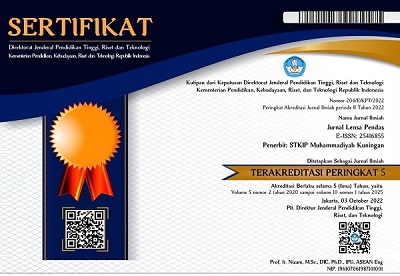Analisis Kemampuan Numerik Siswa Kelas V dalam Mengerjakan Soal Tipe HOTS
Abstract
Numeric capability is a person's capability to formulate, define, and interpret Mathematics in various contexts. This ability is also included in a person's high-level reasoning ability and ability in a problem that is related to digits.This study aims to identify the numeric capabilities of fifth-grade students by carrying out a trial test with numeric questions of the higher order of thinking skill(HOTS) type.The type of research used is qualitative with content analysis method accomplished at Lialang State Elementary School.The research respondent were fifth-grade students consisting of 35 students. The data collection technique was carried out with the interviews, observations, and trial test. The results of the study show that the numerical ability of students has a percentage of 53.33% of the students were in the medium-ability group, and 46,67% of the students were in the low-ability group.
Downloads
References
Aan Komariah dan Djam’an Satori. (2012). Metodelogi Penelitian Kuantitatif. Bandung; Alfabeta.
Barrat, C. (2014). Higher Order Thinking and Assessment. International Seminar on current issues in Primary Education: Prodi PGSD Universitas Muhammadiyah Makasar.
Dekdikbud. (2014). PERMENDIKBUD No.58 Th. 2014 tentang Kurikulum 2013 Sekolah Menengah Pertama/Madrasah Tsanawiyah.
Depdiknas. 2003. Undang-undang RI No.23 tahun 2003 tentang sistem pendidikan nasional.
Eggen, P. K. (2021). Strategi dan model pembelajaran. Jakarta: PT. Indeks.
Haig, Y. (2014). Higher Order of Thinking and Assesment. International Seminar on current issues in Primary Education: Prodi PGSD Universitas Muhammadiyah Makasar.
Kemendikbud, T. G., Jenderal, J., Senayan, S., Pusat, J., & Ristekdikti. (2018). Mengapa literasi sains penting? . Gerakan Literasi Nasional.
Kementerian Pendidikan dan Kebudayaan. (2017). Literasi Numerasi. Jakarta: TIM GLN Kemendikbud
Nuragni, M.S. (2014). Olah Data Penelitian Siswa dalam Menyelesaikan Soal Matematika Tipe Higher Order Thinking pada Pokok Bahasan Pola Bilangan di Kalangan Siswa Kelas VIII E SMP Negeri 5 Yogyakarta TA. 2018/2019. Universitas Sanata Dharma Yogyakarta.
Panggabean, R. F. S. B., & Tamba, K. P. (2020). Kesulitan Belajar Matematika: Analisis Pengetahuan Awal [Difficulty in Learning Mathematics: Prior Knowledge Analysis]. JOHME: Journal of Holistic Mathematics Education, 4(1), 17.
Permendikbud No. 21 Tahun 2016 tentang Standar Isi.
Rohim, D. C. (2021). Konsep Asesmen Konpetensi Minimum Meningkatkan Kemampuan Literasi Numerasi Sekolah Dasar Untuk Siswa. 33, 54-62.
Sudjana. (2017). Penilaian Hasil Proses Belajar Mengajar. Bandung; PT. Remaja Rosdakarya.
Sugiyono, P. D. (2017). Penelitian Kuantitatif Kualitatif dan R&D. BANDUNG: ALVABETA, CV.
Suryapuspitarini, B. K., Wardono, W., & Kartono, K. (2018) Analisis soal matematika higher order thinking skills (HOTS) pada kurikulum 2013 untuk mendukung kemampuan literasi siswa. In PRISMA, Prosiding Seminar Nasional Matematika (Vol. 1, pp. 876-884).
Pusat dan Pembelajaran. ASESMEN KOMPETENSI MINIMUM. https://hasilun.puspendik.kemendikbud.go.id/akm/akm/soal?j=1&l=3&s=33
Syawahid, M. (2019). Mathematical Literacy Algebra Reasoning. 02(1), 33-46.






1.png)









